Chapter 8. Electronic Structure of Atoms
8.4 Electronic Structure of Atoms
Learning Objectives
By the end of this section, you will be able to:
- Derive the predicted ground-state electron configurations of atoms
- Identify and explain exceptions to predicted electron configurations for atoms and ions
- Relate electron configurations to element classifications in the periodic table
Having introduced the basics of atomic structure and quantum mechanics, we can use our understanding of quantum numbers to determine how atomic orbitals relate to one another. This allows us to determine which orbitals are occupied by electrons in each atom. The specific arrangement of electrons in orbitals of an atom determines many of the chemical properties of that atom.
Electronic Structure of Atoms
The arrangement of electrons in the orbitals of an atom is called the electron configuration of the atom. We describe an electron configuration with a symbol that contains three pieces of information (Figure 1):
- The number of the principal quantum shell, n,
- The letter that designates the orbital type also called the subshell, and
- A superscript number that designates the number of electrons in that particular subshell.
For example, the notation 2p4 (read “two–p–four”) indicates four electrons in a p subshell with a principal quantum number (n) of 2. The notation 3d8 (read “three–d–eight”) indicates eight electrons in the d subshell of the principal shell for which n = 3.

The Aufbau Principle
To determine the electron configuration for any particular atom, we can “build” the structures in the order of atomic numbers. Beginning with hydrogen, and continuing across the periods of the periodic table, we add one proton at a time to the nucleus and one electron to the proper subshell until we have described the electron configurations of all the elements. This procedure is called the Aufbau principle, from the German word Aufbau (“to build up”). Each added electron occupies the subshell of lowest energy available (in the order shown in Figure 4 in section 7.3), subject to the limitations imposed by the Pauli exclusion principle. Electrons enter higher-energy subshells only after lower-energy subshells have been filled to capacity. Figure 2 illustrates the traditional way to remember the filling order for atomic orbitals. Since the arrangement of the periodic table is based on the electron configurations, Figure 3 and Figure 4 provides an alternative method for determining the electron configuration. The filling order simply begins at hydrogen and includes each subshell as you proceed in increasing Z order. For example, after filling the 3p block up to Ar, we see the orbital will be 4s (K, Ca), followed by the 3d orbitals.
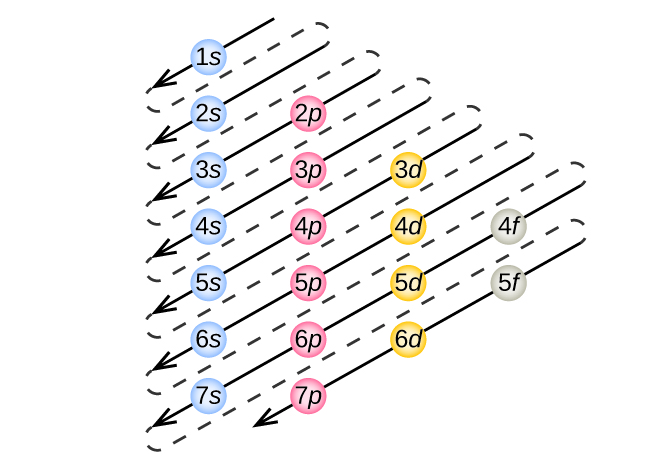
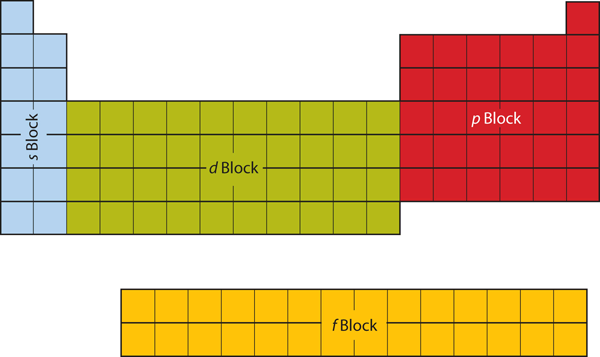
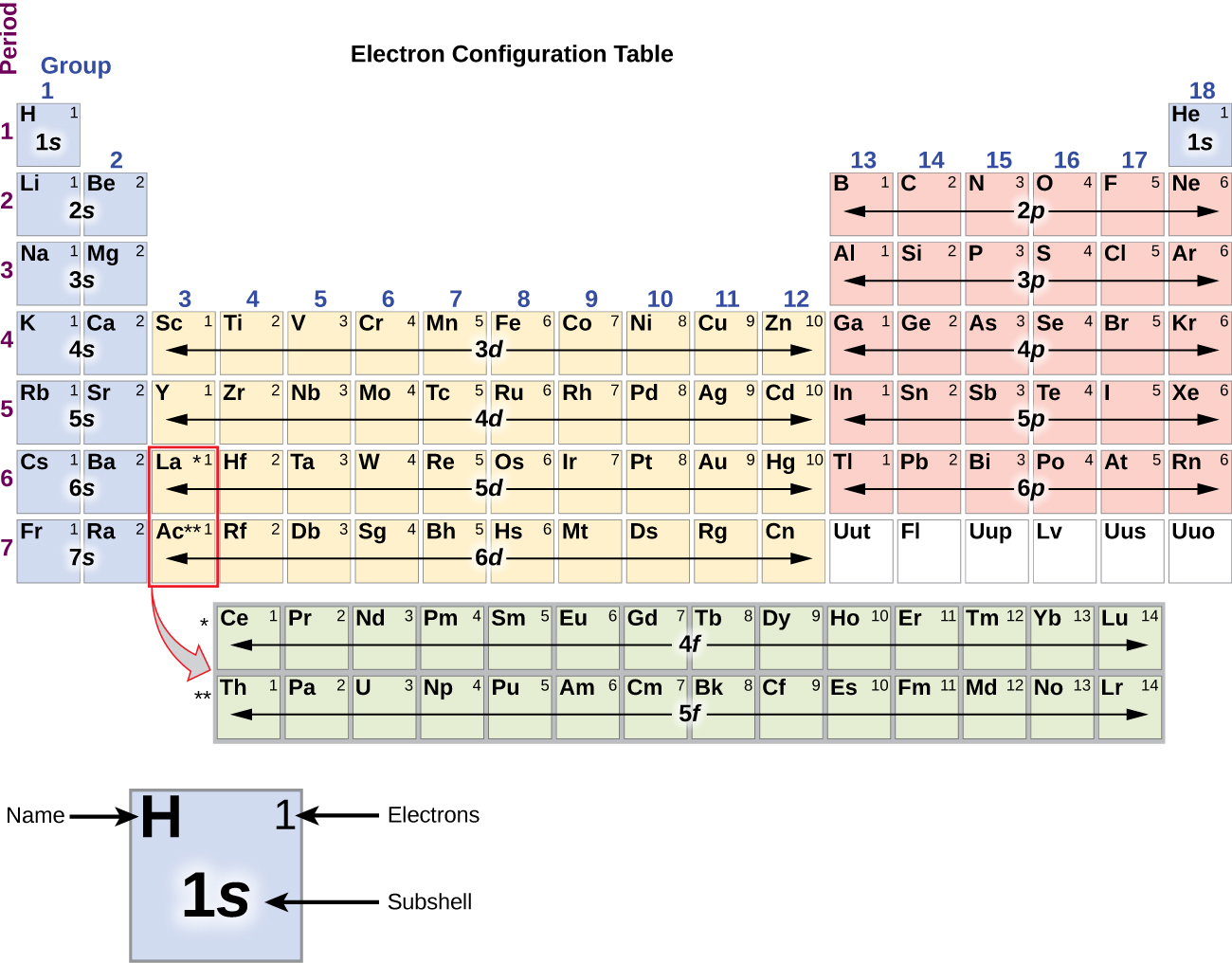
We will now construct the ground-state electron configuration and orbital diagram for a selection of atoms in the first and second periods of the periodic table. Orbital diagrams are pictorial representations of the electron configuration, showing the individual orbitals and the pairing arrangement of electrons. We start with a single hydrogen atom (atomic number 1), which consists of one proton and one electron. Referring to Figure 2 or Figure 3, we would expect to find the electron in the 1s orbital. By convention, spin up = + \frac{1}{2}$ value is usually filled first. The electron configuration and the orbital box diagram are:
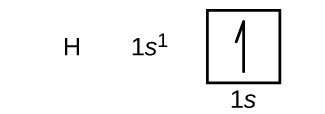
Following hydrogen is the noble gas helium, which has an atomic number of 2. The helium atom contains two protons and two electrons. The two electrons will occupy the same orbital but they will have different spin states, one will be spin-up (˦) and the other spin-down (˨). This is in accord with the Pauli exclusion principle. For orbital diagrams, this means two half-arrows go in each box (representing two electrons in each orbital) and the half-arrows must point in opposite directions (representing paired spins). The electron configuration and orbital box diagram of helium are:
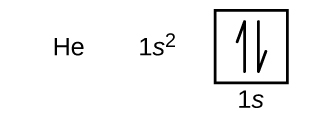
The n = 1 shell is completely filled in a helium atom.
The next atom is the alkali metal lithium with an atomic number of 3. The first two electrons in lithium fill the 1s orbital. The remaining electron must occupy the orbital of next lowest energy, the 2s orbital (Figure 2 or Figure 3). Thus, the electron configuration and orbital box diagram of lithium are:

An atom of the alkaline earth metal beryllium, with an atomic number of 4, contains four protons in the nucleus and four electrons surrounding the nucleus. The fourth electron fills the remaining space in the 2s orbital.

An atom of boron (atomic number 5) contains five electrons. The n = 1 shell is filled with two electrons and three electrons will occupy the n = 2 shell. Because any s subshell can contain only two electrons, the fifth electron must occupy the next energy level, which will be a 2p orbital. There are three degenerate 2p orbitals, meaning they are equal in energy, and the electron can occupy any one of these p orbitals. When drawing orbital diagrams, we include empty boxes to depict any empty orbitals in the same subshell that we are filling.

In the orbital box diagrams, notice the space between the box for the 1s and 2s orbitals – space between boxes are used to indicate a difference in energy. Therefore, a ” lack of space” between boxes, indicate the orbitals are degenerate, meaning equal in energy.
Carbon (atomic number 6) has six electrons. Four of them fill the 1s and 2s orbitals. The remaining two electrons occupy the 2p subshell. We now have a choice of filling one of the 2p orbitals and pairing the electrons or of leaving the electrons unpaired in two different, but degenerate, p orbitals. The orbitals are filled as described by Hund’s rule: the lowest-energy configuration for an atom with electrons within a set of degenerate orbitals is that having the maximum number of unpaired electrons. Thus, the two electrons in the carbon 2p orbitals occupy different p-orbitals – this minimizes electron-electron repulsion within the atom. The electron configuration and orbital box diagram for carbon are:

Nitrogen (atomic number 7) fills the 1s and 2s subshells and has one electron in each of the three 2p orbitals, in accordance with Hund’s rule. These three electrons have unpaired spins. Oxygen (atomic number 8) has a pair of electrons in any one of the 2p orbitals (the electrons have opposite spins) and a single electron in each of the other two. Fluorine (atomic number 9) has only one 2p orbital containing an unpaired electron. All of the electrons in the noble gas neon (atomic number 10) are paired, and all of the orbitals in the n = 1 and the n = 2 shells are filled. The electron configurations and orbital box diagrams of these four elements are:
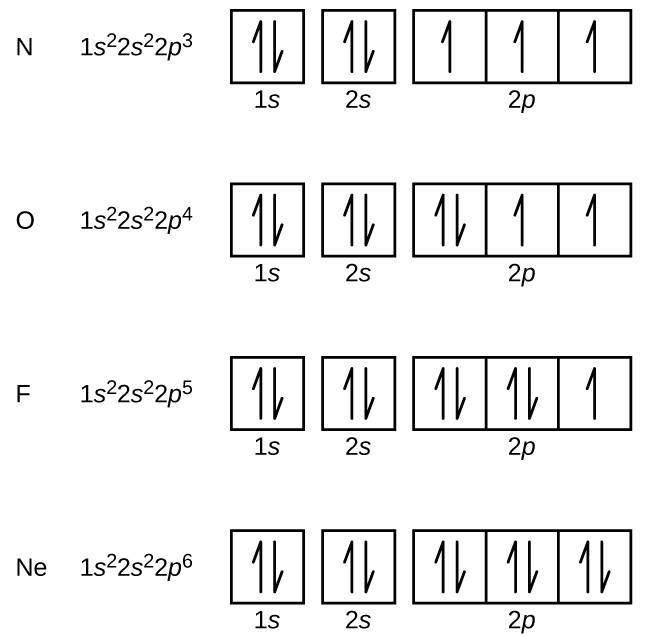
The alkali metal sodium (atomic number 11) has one more electron than the neon atom. This electron must go into the lowest-energy subshell available, the 3s orbital, giving a 1s22s22p63s1 configuration. The electrons occupying the outermost shell orbital(s) (highest value of n) are called outer electrons, and those occupying the inner shell orbitals are called core electrons or inner electrons (Figure 4). Valence electrons are outer electrons plus any electrons found in partially filled d or f orbitals. Often valence electron are the same as the outer electrons. But there are examples where there is a difference. Since the core electron shells correspond to noble gas electron configurations, we can abbreviate electron configurations by writing the noble gas that matches the core electron configuration, along with the valence electrons in a condensed format. For our sodium example, the symbol [Ne] represents core electrons, (1s22s22p6) and our abbreviated or condensed electron configuration is [Ne]3s1.
![This figure includes the element symbol N a, followed by the electron configuration for the element. The first part of the electron configuration, 1 s superscript 2 2 s superscript 2 2 p superscript 6, is shaded in purple and is labeled, “core electrons.” The last portion, 3 s superscript 1, is shaded orange and is labeled, “valence electron.” To the right of this configuration is the word “Abbreviation” followed by [ N e ] 3 s superscript 1.](https://pressbooks.bccampus.ca/chem1114langaracollege/wp-content/uploads/sites/387/2018/04/CNX_Chem_06_04_Valence-2.jpg)
Similarly, the condensed electron configuration of lithium can be represented as [He]2s1, where [He] represents the configuration of the helium atom, which is identical to that of the filled inner shell of lithium. Writing the configurations in this way emphasizes the similarity of the configurations of lithium and sodium. Both atoms, which are in the alkali metal family, have only one electron in a valence s subshell outside a filled set of inner shells.
The alkaline earth metal magnesium (atomic number 12), with its 12 electrons in a [Ne]3s2 configuration, is analogous to its family member beryllium, [He]2s2. Both atoms have a filled s subshell outside their filled inner shells. Aluminum (atomic number 13), with 13 electrons and the condensed electron configuration [Ne]3s23p1, is analogous to its family member boron, [He]2s22p1.
The electron configurations of silicon (14 electrons), phosphorus (15 electrons), sulfur (16 electrons), chlorine (17 electrons), and argon (18 electrons) are analogous in the electron configurations of their outer shells to their corresponding family members carbon, nitrogen, oxygen, fluorine, and neon, respectively, except that the principal quantum number of the outer shell of the heavier elements has increased by one to n = 3. Figure 5 shows the lowest energy, or ground-state, electron configuration for these elements as well as that for atoms of each of the known elements.
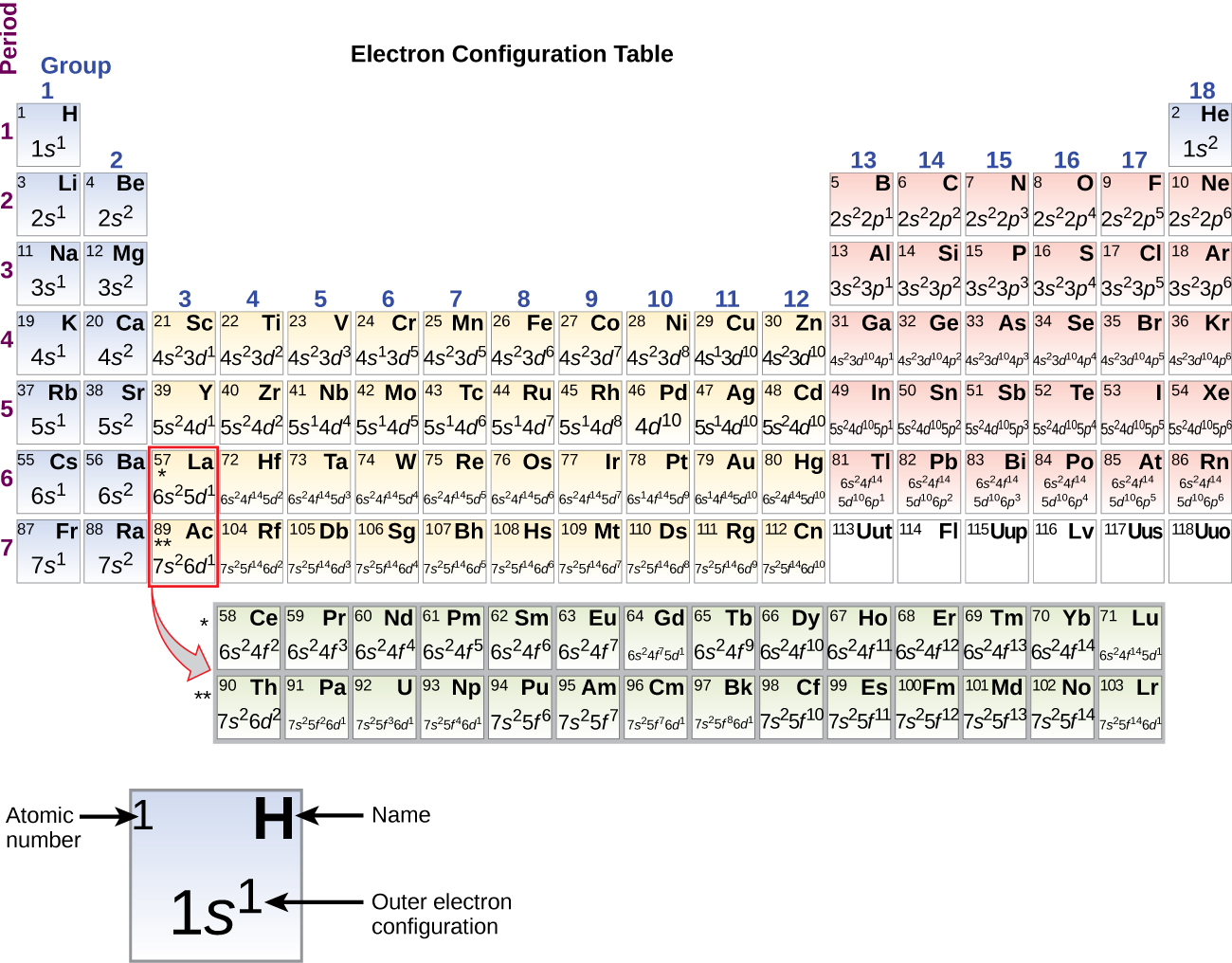
When we come to the next element in the periodic table, the alkali metal potassium (atomic number 19), we might expect that we would begin to add electrons to the 3d subshell. However, all available chemical and physical evidence indicates that potassium is like lithium and sodium, and that the next electron is not added to the 3d level but is, instead, added to the 4s level (Figure 5). Thus, potassium has an electron configuration of [Ar]4s1. Hence, potassium corresponds to Li and Na in its valence shell configuration. The next electron is added to complete the 4s subshell and calcium has an electron configuration of [Ar]4s2. This gives calcium an outer-shell electron configuration corresponding to that of beryllium and magnesium.
Beginning with the transition metal scandium (atomic number 21), additional electrons are added successively to the 3d subshell. This subshell is filled to its capacity with 10 electrons. The 4p subshell fills next. Note that for three series of elements, scandium (Sc) through copper (Cu), yttrium (Y) through silver (Ag), and lutetium (Lu) through gold (Au), a total of 10 d electrons are successively added to the (n – 1) shell next to the n shell to bring that (n – 1) shell from 8 to 18 electrons. For two series, lanthanum (La) through lutetium (Lu) and actinium (Ac) through lawrencium (Lr), 14 f electrons are successively added to the (n – 2) shell to bring that shell from 18 electrons to a total of 32 electrons.
Example 1
What is the electron configuration and orbital box diagram for a phosphorus atom?
Solution
The atomic number of phosphorus is 15. Thus, a phosphorus atom contains 15 electrons. The order of filling of the energy levels is 1s, 2s, 2p, 3s, 3p, 4s, . . . The 15 electrons of the phosphorus atom will fill up to the 3p orbital, which will contain three electrons:

The last electron added is a 3p electron.
Test Yourself
Identify the atoms from the condensed electron configurations given:
a) [Ar]4s23d5
b) [Kr]5s24d105p6
Answers
a) Mn b) Xe
Example 2
a) What is the electron configuration for Na, which has 11 electrons?
b) What is the predicted electron configuration for Sn, which has 50 electrons?
Solution
a) The first two electrons occupy the 1s subshell. The next two occupy the 2s subshell, while the next six electrons occupy the 2p subshell. This gives us 10 electrons so far, with 1 electron left. This last electron goes into the n = 3 shell, s subshell. Thus, the electron configuration of Na is 1s22s22p63s1.
b) We will follow the chart in Figure 2 until we can accommodate 50 electrons in the subshells in the proper order:
Sn: 1s22s22p63s23p64s23d104p65s24d105p2
Verify by adding the superscripts, which indicate the number of electrons: 2 + 2 + 6 + 2 + 6 + 2 + 10 + 6 + 2 + 10 + 2 = 50, so we have placed all 50 electrons in subshells in the proper order.
Test Yourself
a) What is the electron configuration for Mg, which has 12 electrons?
b) What is the electron configuration for Ba, which has 56 electrons?
Answer
a) 1s22s22p63s2 b) 1s22s22p63s23p64s23d104p65s24d105p66s2
Example 3
What is the abbreviated electron configuration for P, which has 15 electrons?
Solution
With 15 electrons, the electron configuration of P is
P: 1s22s22p63s23p3
The first immediate noble gas is Ne, which has an electron configuration of 1s22s22p6. Using the electron configuration of Ne to represent the first 10 electrons, the abbreviated electron configuration of P is
P: [Ne]3s23p3
Test Yourself
What is the abbreviated electron configuration for Rb, which has 37 electrons?
Answer
[Kr]5s1
The periodic table can be a powerful tool in predicting the electron configuration of an element. However, we do find exceptions to the order of filling of orbitals that are shown in Figure 2 or Figure 3. For instance, the electron configurations (shown in Figure 5) of the transition metals chromium (Cr; atomic number 24) and copper (Cu; atomic number 29), among others, are not those we would expect. In general, such exceptions involve subshells with very similar energy, and small effects can lead to changes in the order of filling.
In the case of Cr and Cu, we find that half-filled and completely filled subshells apparently represent conditions of preferred stability. This stability is such that an electron shifts from the 4s into the 3d orbital to gain the extra stability of a half-filled 3d subshell (in Cr) or a filled 3d subshell (in Cu). Other exceptions also occur. For example, niobium (Nb, atomic number 41) is predicted to have the electron configuration [Kr]5s24d3. Experimentally, we observe that its ground-state electron configuration is actually [Kr]5s14d4. We can rationalize this observation by saying that the electron–electron repulsions experienced by pairing the electrons in the 5s orbital are larger than the gap in energy between the 5s and 4d orbitals. There is no simple method to predict the exceptions for atoms where the magnitude of the repulsions between electrons is greater than the small differences in energy between subshells.
Electron Configurations and the Periodic Table
As described earlier, the periodic table arranges atoms based on increasing atomic number so that elements with the same chemical properties recur periodically. When their electron configurations are added to the table (Figure 5), we also see a periodic recurrence of similar electron configurations in the outer shells of these elements. Because they are in the outer shells of an atom, valence electrons play the most important role in chemical reactions. The outer electrons have the highest energy of the electrons in an atom and are more easily lost or shared than the core electrons. Valence electrons are also the determining factor in some physical properties of the elements.
Elements in any one group (or column) have the same number of valence electrons; the alkali metals lithium and sodium each have only one valence electron, the alkaline earth metals beryllium and magnesium each have two, and the halogens fluorine and chlorine each have seven valence electrons. The similarity in chemical properties among elements of the same group occurs because they have the same number of valence electrons. It is the loss, gain, or sharing of valence electrons that defines how elements react.
It is important to remember that the periodic table was developed on the basis of the chemical behavior of the elements, well before any idea of their atomic structure was available. Now we can understand why the periodic table has the arrangement it has—the arrangement puts elements whose atoms have the same number of valence electrons in the same group. This arrangement is emphasized in Figure 5, which shows in periodic-table form the electron configuration of the last subshell to be filled by the Aufbau principle. The colored sections of Figure 5 show the three categories of elements classified by the orbitals being filled: main group, transition, and inner transition elements. These classifications determine which orbitals are counted in the valence shell, or highest energy level orbitals of an atom.
1. Main group elements (sometimes called representative elements) are those in which the last electron added enters an s or a p orbital in the outermost shell, shown in blue and red in Figure 5. This category includes all the nonmetallic elements, as well as many metals and the intermediate semimetallic elements. The valence electrons for main group elements are those with the highest n level. For example, gallium (Ga, atomic number 31) has the electron configuration [Ar]4s23d104p1, which contains three valence electrons (in bold). The completely filled d orbitals count as core, not valence, electrons.
2. Transition elements or transition metals. These are metallic elements in which the last electron added enters a d orbital. The valence electrons are the electrons in the outermost shell and also include any electrons in partially filled d or f orbitals, as these electrons are also very reactive and have a higher energy despite their lower shell value. The official IUPAC definition of transition elements specifies those with partially filled d orbitals. Thus, the elements with completely filled orbitals (Zn, Cd, Hg, as well as Cu, Ag, and Au in Figure 5) are not technically transition elements. However, the term is frequently used to refer to the entire d block (colored yellow in Figure 5), and we will adopt this usage in this textbook.
3. Inner transition elements are metallic elements in which the last electron added occupies an f orbital. They are shown in green in Figure 5. The valence shells of the inner transition elements consist of the (n – 2)f, the (n – 1)d, and the ns subshells. There are two inner transition series:
a) The lanthanide series: lanthanide (La) through lutetium (Lu)
b) The actinide series: actinide (Ac) through lawrencium (Lr)
Lanthanum and actinium, because of their similarities to the other members of the series, are included and used to name the series, even though they are transition metals with no f electrons.
Electron Configurations of Ions
We have seen that ions are formed when atoms gain or lose electrons. A cation (positively charged ion) forms when one or more electrons are removed from a parent atom. For main group elements, the electrons that were added last are the first electrons removed. For transition metals and inner transition metals, however, electrons in the s orbital are easier to remove than the d or f electrons, and so the highest ns electrons are lost, and then the (n – 1)d or (n – 2)f electrons are removed. An anion (negatively charged ion) forms when one or more electrons are added to a parent atom. The added electrons fill in the order predicted by the Aufbau principle.
Example 4
What is the electron configuration and orbital diagram of:
a) Na+ b) P3– c) Al2+ d) Fe2+ e) Sm3+
Solution
First, write out the electron configuration for each parent atom. We have chosen to show the full, unabbreviated configurations to provide more practice for students who want it, but listing the core-abbreviated electron configurations is also acceptable.
Next, determine whether an electron is gained or lost. Remember electrons are negatively charged, so ions with a positive charge have lost an electron. For main group elements, the last orbital gains or loses the electron. For transition metals, the last s orbital loses an electron before the d orbitals.
a) Na: 1s22s22p63s1.
Sodium cation loses one electron, so Na+: 1s22s22p63s1 = Na+: 1s22s22p6.
b) P: 1s22s22p63s23p3.
Phosphorus trianion gains three electrons, so P3−: 1s22s22p63s23p6.
c) Al: 1s22s22p63s23p1.
Aluminum dication loses two electrons Al2+: 1s22s22p63s23p1 =
Al2+: 1s22s22p63s1.
d) Fe: 1s22s22p63s23p64s23d6.
Iron(II) loses two electrons and, since it is a transition metal, they are removed from the 4s orbital Fe2+: 1s22s22p63s23p64s23d6 = 1s22s22p63s23p63d6.
e). Sm: 1s22s22p63s23p64s23d104p65s24d105p66s24f6.
Samarium trication loses three electrons. The first two will be lost from the 6s orbital, and the final one is removed from the 4f orbital. Sm3+: 1s22s22p63s23p64s23d104p65s24d105p66s24f6 = 1s22s22p63s23p64s23d104p65s24d105p64f5.
Test Yourself
Which ion with a +2 charge has the electron configuration 1s22s22p63s23p63d104s24p64d5? Which ion with a +3 charge has this configuration?
Answers
Tc2+, Ru3+
Food and Drink App: Artificial Colors
The color of objects comes from a different mechanism than the colors of neon and other discharge lights. Although colored lights produce their colors, objects are colored because they preferentially reflect a certain color from the white light that shines on them. A red tomato, for example, is bright red because it reflects red light while absorbing all the other colors of the rainbow.
Many foods, such as tomatoes, are highly colored; in fact, the common statement “you eat with your eyes first” is an implicit recognition that the visual appeal of food is just as important as its taste. But what about processed foods?
Many processed foods have food coloring added to them. There are two types of food coloring: natural and artificial. Natural food coloring include caramelized sugar for brown; annatto, turmeric, and saffron for various shades of orange or yellow; betanin from beets for purple; and even carmine, a deep red dye that is extracted from the cochineal, a small insect that is a parasite on cacti in Central and South America. (That’s right: you may be eating bug juice!)
Some coloring agents are artificial. In the United States, the Food and Drug Administration currently approves only seven compounds as artificial coloring in food, beverages, and cosmetics:
- FD&C Blue #1: Brilliant Blue FCF
- FD&C Blue #2: Indigotine
- FD&C Green #3: Fast Green FCF
- RD&C Red #3: Erythrosine
- FD&C Red #40: Allura Red AC
- FD&C Yellow #5: Tartrazine
- FD&C Yellow #6: Sunset Yellow FCF
Lower-numbered colors are no longer on the market or have been removed for various reasons. Typically, these artificial coloring agents are large molecules that absorb certain colors of light very strongly, making them useful even at very low concentrations in foods and cosmetics. Even at such low amounts, some critics claim that a small portion of the population (especially children) is sensitive to artificial coloring and urge that their use be curtailed or halted. However, formal studies of artificial coloring and their effects on behaviour have been inconclusive or contradictory. Despite this, most people continue to enjoy processed foods with artificial coloring like those shown in Figure 6.
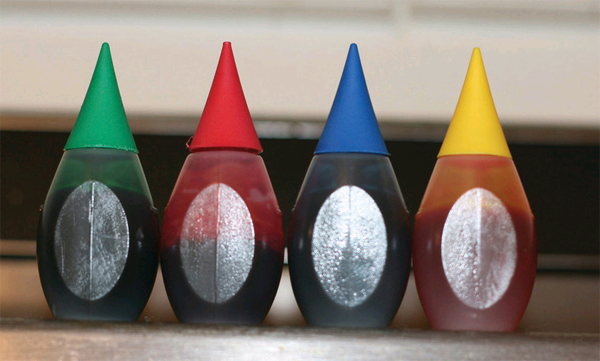
Key Concepts and Summary
The relative energy of the subshells determine the order in which atomic orbitals are filled (1s, 2s, 2p, 3s, 3p, 4s, 3d, 4p, and so on). Electron configurations and orbital diagrams can be determined by applying the Pauli exclusion principle (no two electrons can have the same set of four quantum numbers) and Hund’s rule (whenever possible, electrons retain unpaired spins in degenerate orbitals).
Electrons in the outermost orbitals, called valence electrons, are responsible for most of the chemical behavior of elements. In the periodic table, elements with analogous valence electron configurations usually occur within the same group. There are some exceptions to the predicted filling order, particularly when half-filled or completely filled orbitals can be formed. The periodic table can be divided into three categories based on the orbital in which the last electron to be added is placed: main group elements (s and p orbitals), transition elements (d orbitals), and inner transition elements (f orbitals).
Exercises
1. Read the labels of several commercial products and identify monatomic ions of at least six main group elements contained in the products. Write the complete electron configurations of these cations and anions.
2. Using complete subshell notation (1s22s22p6, and so forth), predict the electron configuration of each of the following atoms:
a) N b) Si c) Fe d) Te e) Tb
3. What additional information do we need to answer the question “Which ion has the electron configuration 1s22s22p63s23p6”?
4. Use an orbital diagram to describe the electron configuration of the valence shell of each of the following atoms:
a) N b) Si c) Fe d) Te e) Mo
5. Which atom has the electron configuration 1s22s22p63s23p64s23d104p65s24d2?
6. Which ion with a +1 charge has the electron configuration 1s22s22p63s23p63d104s24p6? Which ion with a –2 charge has this configuration?
7. Which of the following has two unpaired electrons?
a) Mg b) Si c) S d) Both Mg and S e) Both Si and S.
8. Which atom would be expected to have a half-filled 4s subshell?
9. Thallium was used as a poison in the Agatha Christie mystery story “The Pale Horse.” Thallium has two possible cationic forms, +1 and +3. The +1 compounds are the more stable. Write the electron structure of the +1 cation of thallium.
10. Cobalt–60 and iodine–131 are radioactive isotopes commonly used in nuclear medicine. How many protons, neutrons, and electrons are in atoms of these isotopes? Write the complete electron configuration for each isotope.
11. How many subshells are completely filled with electrons for Na? How many subshells are unfilled?
12. What is the maximum number of electrons in the entire n = 2 shell?
13. Write the complete electron configuration for each atom.
a) Si, 14 electrons b) Sc, 21 electrons
14. Write the complete electron configuration for each atom.
a) Cd, 48 electrons b) Mg, 12 electrons
15. Write the abbreviated electron configuration for each atom in Exercise 13.
16. Write the abbreviated electron configuration for each atom in Exercise
17. Where on the periodic table are s subshells being occupied by electrons?
18. In what block is Ra found?
19. What are the valence shell electron configurations of the elements in the second column of the periodic table?
20. What are the valence shell electron configurations of the elements in the first column of the p block?
21. From the element’s position on the periodic table, predict the electron configuration of each atom.
a) Sr b) S
22. From the element’s position on the periodic table, predict the electron configuration of each atom.
a) V b) Ar
23. From the element’s position on the periodic table, predict the electron configuration of each atom.
a) Ge b) C
Answers
1. For example, Na+: 1s22s22p6; Ca2+: 1s22s22p6;
Sn2+: 1s22s22p63s23p63d104s24p64d105s2; F–: 1s22s22p6;
O2–: 1s22s22p6; Cl–: 1s22s22p63s23p6.
2. a) 1s22s22p3 b) 1s22s22p63s23p2 c) 1s22s22p63s23p64s23d6
d) 1s22s22p63s23p64s23d104p65s24d105p4
e) 1s22s22p63s23p64s23d104p65s24d105p66s24f9
3. The charge on the ion.
4. a)

b)

c)

d)

e)

5. Zr
6. Rb+, Se2−
7. Although both b) and c) are correct, e) encompasses both and is the best answer.
8. K
9. 1s22s22p63s23p63d104s24p64d105s25p66s24f145d10
10. Co has 27 protons, 27 electrons, and 33 neutrons: 1s22s22p63s23p64s23d7.
I has 53 protons, 53 electrons, and 78 neutrons: 1s22s22p63s23p63d104s24p64d105s25p5.
11. Three subshells (1s, 2s, 2p) are completely filled, and one shell (3s) is partially filled.
12. 8 electrons
13. a) 1s22s22p63s23p2 b) 1s22s22p63s23p64s23d1
14. a) 1s22s22p63s23p64s23d104p65s24d10 b) 1s22s22p63s2
15. a) [Ne]3s23p2 b) [Ar]4s23d1
16. a) [Kr]5s24d10 b) [Ne]3s2
17. the first two columns
18. the s block
19. ns2
20. ns2np1
21. a) 1s22s22p63s23p64s23d104p65s2 b) 1s22s22p63s23p4
22. a) 1s22s22p63s23p64s23d3 b) 1s22s22p63s23p6
23. a) 1s22s22p63s23p64s23d104p2 b) 1s22s22p2
Glossary
Aufbau principle: procedure in which the electron configuration of the elements is determined by “building” them in order of atomic numbers, adding one proton to the nucleus and one electron to the proper subshell at a time
core electron: electron in an atom that occupies the orbitals of the inner shells
electron configuration: electronic structure of an atom in its ground state given as a listing of the orbitals occupied by the electrons
Hund’s rule: every orbital in a subshell is singly occupied with one electron before any one orbital is doubly occupied, and all electrons in singly occupied orbitals have the same spin
orbital diagram: pictorial representation of the electron configuration showing each orbital as a box and each electron as a half-arrow
valence electrons: are the electrons in the outermost shell and also include any electrons in partially filled d or f orbitals, as these electrons are also very reactive and have a higher energy despite their lower shell value of a ground-state atom; they determine how an element reacts
valence shell: outermost shell of electrons in a ground-state atom; for main group elements, the orbitals with the highest n level (s and p subshells) are in the valence shell, while for transition metals, the highest energy s and d subshells make up the valence shell and for inner transition elements, the highest s, d, and f subshells are included

